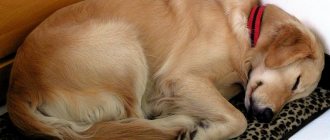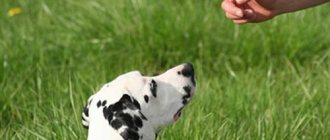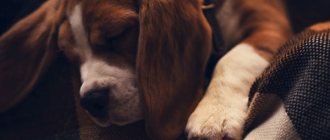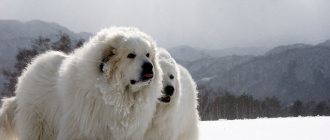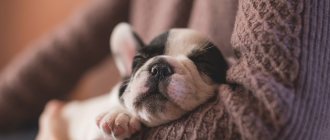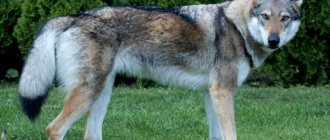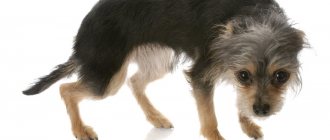The Czechoslovakian Wolfdog is a dog breed that is rightfully considered universal. Czechoslovakian breeders were involved in breeding the dogs; the work was carried out in the mid-20th century. It was possible to obtain this breed thanks to bold experiments. Breeders crossed an ordinary dog with wolves. The Czechoslovakian Wolfdog differs from other dog breeds in its strong immune system, developed intelligence, independence, and endurance.
History of the origin of the Czechoslovakian Wolfdog breed
Military operations required dogs that could combine the working qualities of a German shepherd and a Carpathian wolf. This work fell on the shoulders of Czech breeders. They decided to crossbreed 48 shepherd dogs and 4 wolves. The result of this work was the birth of the Czechoslovakian Wolfdog, which was distinguished by its bright temperament, pack instinct, lightning-fast decision-making, and the ability to quickly learn new things.
After some time, the wolf breed of dogs began to be actively used not only in military operations, but also in search and rescue activities, protective and guard activities. In addition, dogs often took part in hunting. Gradually, animals found their use in sports - towing, agility, obedience.
The year 1982 was significant. It was at this time that the Czechoslovakian wolf breed was officially recognized as national. After 17 years, the dogs were recognized by the International Canine Federation. During this period, the popularization of the breed began; animals began to spread to other countries around the world.
Breed Features
This species has its own unique characteristics that set them apart from all other dogs:
- amazing endurance, allowing them to run 100 kilometers or more without signs of fatigue;
- great strength - wolfdogs can easily transport a person;
- the bite force of the Czechoslovakian wolfdog is one of the greatest in the world - this is due to the fact that German shepherds, like other ancestors, the wolfdog, wild wolves, are an extremely dangerous breed;
- ability to amble;
- wolfdogs cannot bark, but they can howl.
In Norway, keeping these dogs at home is prohibited.
Czechoslovakian Wolfdog breed description
The Czechoslovakian Wolfdog differs from other breeds in its rectangular body shape and strong build, as a result of which the dogs can work and run for a long period of time. In appearance they resemble wolves. In addition, they have a similar coat structure, color, and the presence of a specific mask, which is not typical for dogs.
The Czech Shepherd is quite temperamental, sociable, but unobtrusive, and inquisitive. They are more distrustful of people, but behave with restraint in their company. Dogs differ depending on their gender. The differences affect only the appearance; this does not affect the character in any way.
Males can reach a height at the withers of up to 70 cm, weight about 26-30 kg. Smaller females: height about 65 cm, weight from 20 kg.
Size and appearance
The Czechoslovakian wolf breed is distinguished by its impressive size and proportional body. At the same time, the appearance resembles a wolf. From birth, dogs have strong teeth and developed muscles. Despite their large size, the dogs look harmonious and move easily.
The head has a proportional shape, its appearance more like a wedge with a blunt end. The frontal groove is practically not expressed, but the tubercle on the back of the head is clearly visible.
The eyes are small, the nose is oval. The lips are tight, there are no pockets. There is a straight and scissor bite. There are brown, black and multi-colored eyes.
The ears are triangular in shape, small in size and quite thin. If you look closely at the animal, you will notice that the upper corner of the eye is at the same level as the outer edge of the ear.
Thanks to its long neck, the dog is able to reach the surface of the ground with its nose.
Limbs are strong and muscular. The front paws are set close, you can see that the paws are slightly turned out. The hind limbs are parallel.
Attention! At exhibitions these breed standards are taken into account. The reason for disqualification is not only deviations from them, but also excessive cowardice or aggression of the animal.
Lifespan
This breed of dog differs from other animals by its maximum similarity to its ancestors - wolves. They have not only a bright appearance, but also a serious character. This breed, despite its small number, is known throughout the world. In the Czech Republic, laboratory tests are regularly carried out, the purpose of which is to identify possible deviations in health. Only if the results are good, then the dogs are used for breeding. The average life expectancy is 14 years.
Character
If we take into account the description of the breed, then this breed can rightfully be considered unique. They differ in temperament not only from dogs, but also from wolves. It is recommended to breed only experienced breeders, as breeding requires certain knowledge and experience. In addition, the breeder must have a strong character and become a true leader. The owner is not only an authority, but also a leader.
If you create favorable conditions for keeping, the following character traits will appear:
- Dogs are devoted to their owner and the property they protect. In case of danger, they are capable of sacrificing their own life.
- A characteristic feature is courage. In times of danger, the wolf does not take into account the number and size of the offenders; he rushes to defense, showing wolf ferocity.
- Thanks to its developed intelligence, the reaction manifests itself with lightning speed even in extreme situations.
- An integral character trait is endurance. Dogs are able to cover distances of up to 100 km without ever stopping to rest.
- Natural hunting instincts affect the fact that animals are actively used for hunting.
- Despite their genetic predisposition, they get along well with other pets.
In addition, representatives of this breed are no strangers to the joys of a dog; they also enjoy attention, care and love from their owner.
Attitude towards others
The Czechoslovakian Wolfdog breed is perfect for experienced dog breeders, as a beginner is unlikely to be able to cope with it. With other pets - cats and dogs, wolves have different relationships. However, if the animals grew up together from an early age, then emotions towards each other will be extremely positive.
The wolfdog is characterized by leadership qualities, so the owner must build the correct hierarchy from the first days. It is the owner who must become a leader, authority, leader for the dog. Dogs are distrustful of strangers. It is impossible to bribe them even with the most delicious delicacies - the dog is always faithful to its owner.
Attitude towards children
If you plan to bring a wolfdog into your family, then you should understand that he will be wary of new family members. They take a very long time to get used to, and often do not accept the person at all. Therefore, if you plan to have children, it is important to remember that the baby may not be accepted by the dog.
They try to show tolerance towards children, but they do not like to be treated rudely or familiarly. In addition, they consider children to be creatures of a lower rank, so they do not feel much love or respect. Thus, the Czechoslovakian wolfdog breed is not recommended for families with small children.
Intelligence
As the dog grows older, it begins to change, and along with it, its character and intelligence change. This breed has developed intuition, thanks to which dogs can understand the mood of all family members, especially the owner. If a dog senses that a person is upset, he will definitely come over to comfort him. In case of happiness, the dog tries to imbue him with the same feeling. If a person is not in the mood for contact, then they will never impose their communication. Quite proud and independent. Without communication, dogs become aggressive and suspicious.
External standard
Description of the Czechoslovakian Wolfdog breed looks like this:
- The head is shaped like a blunt wedge.
- Rectangular body shape.
- Clear lines of the muzzle.
- Amber eyes.
- Small erect ears.
- Strong limbs.
- High set tail.
- Weight is at least 20 kg for females and 26 for males.
- Height at least 60 cm at the withers for females and 65 for males
Wolfdogs have a zonal coloration with characteristic white markings on the chest.
Education and training
The Czechoslovakian wolf breed can be trained, but this will require a lot of effort and patience. It is important to remember that the dog is quite complex. Since the dog is not only emotional, but also smart, it will constantly look for ways to outwit its owner and disrupt training. In this matter, the most important thing is persistence, firmness of intentions and character. The Czechoslovakian Wolfdog should under no circumstances set the rules.
During training, it is recommended to adhere to the basic rules:
- Keep yourself in control. It’s not the best option to raise your head at the dog and take out your anger on her.
- Don't panic. The owner is the leader of the pack, who can always control the dog. When panic appears, the pet will immediately feel it, after which trust will disappear completely.
- Do not harm the animal. Any cruelty to a pet is prohibited, otherwise aggression cannot be avoided.
- Encouragement. It is recommended to reward the Czechoslovakian Wolfdog for obedience. You can use more than just treats for this. The dog will be pleased to hear praise from the owner.
If you follow these rules, then there will be no problems during education and training.
Description
The Czechoslovakian wolfdog is almost identical to the wolf and is extremely easy to confuse with it. Like wolves, they have pronounced sexual dimorphism. This means that males and females differ significantly in size.
The wolfdog is smaller in size than other wolf-dog hybrids, but this is due to the fact that the Carpathian wolf, which is small in itself, was used during breeding.
Males at the withers reach 65 cm and weigh 26 kg, females 60 cm and weigh 20 kg. This breed should look natural, without pronounced features. They are very muscular and athletic, but these features are hidden under their thick coat.
The similarity with a wolf is manifested in the structure of the head. It is symmetrical, in the shape of a blunt wedge. The stop is smooth, almost imperceptible. The muzzle is very long and 50% longer than the skull, but not particularly wide. The lips are dense, the jaws are strong, the bite is scissor or straight.
The nose is oval-shaped, black. The eyes are small, slanted, amber or light brown. The ears are short, triangular in shape, erect. They are very active and clearly express the dog’s mood and feelings. The impression from the dog is wildness and strength. The condition of the coat depends significantly on the season. In winter, the coat is thick and dense, especially the undercoat.
In summer, it is much shorter and not so thick. It should cover the dog's entire body, including in places where other purebred breeds do not have it: in the ears, inner thighs, scrotum.
Its color is similar to that of the Carpathian wolf, zonal, from yellow-gray to silver-gray. There is a small mask on the muzzle, the fur is slightly darker on the neck and chest. A rarer, but acceptable color is dark gray.
From time to time, wolf cubs are born with alternative colors, for example, black or without a mask on the face. Such dogs cannot be allowed for breeding or showing, but retain all the qualities of the breed.
Application
Initially, the Czechoslovakian Wolfdog was bred to participate in military operations. In modern life, the wolfdog's remarkable set of qualities has made it simply a universal dog.
It is good for search and rescue work, in protective guard duty, along with the Groenendael and Hovawart .
Heightened canine instincts and wolf health allow him to be a good hunter and tracker, and his devotion to the pack and fearlessness make it possible to use the dog to protect herds of domestic animals.
The Czechoslovakian Wolfdog puppy looks like a small wolf cub.
Advantages and disadvantages
Advantages:
- Dogs of the Czechoslovakian Wolf breed have high endurance and can live in any conditions.
- They are universal because they can serve as a protector, guard, hunter, or bloodhound.
- In emergency situations, they are able to make independent decisions.
- They will defend their family even when their own lives are threatened.
Flaws:
- Not suitable for novice dog owners.
- He likes to dominate; during training, the owner needs to be patient and diligent.
- Requires daily walks with physical activity.
Health and diseases of the Czechoslovakian Wolfdog
The Czechoslovakian Wolfdog has a fairly strong immune system. Thanks to the high-quality work of breeders, this breed of dogs does not have genetic diseases. However, despite the fact that animals are hardy, they have weaknesses. Thus, in the process of life, diseases associated with the musculoskeletal system appear. The most common condition is hip dysplasia.
According to veterinarians, diseases appear in dogs for the following reasons:
- Incorrectly formulated diet.
- There is a calcium deficiency.
- The dog has little physical activity.
- Injuries in animals were treated independently or untimely.
- Slippery finish floor covering.
Important! The diagnosis should not be considered a death sentence. Any disease can be cured. But this requires understanding that it will take a lot of time, effort, and money.
Diseases and treatment
Czech wolfdogs have strong, truly wolf-like health. And thanks to high-quality breeding work, they do not have genetic diseases. However, even such hardy and strong pets have their “Achilles heel”. They have a predisposition to the development of pathologies of the musculoskeletal system, but not of a congenital nature. The most common diagnosis in dogs is hip dysplasia.
Veterinarians say that the disease develops against the background of the following factors:
- poor nutrition;
- calcium deficiency in the diet;
- insufficient physical activity;
- short walks or no walks;
- untimely or independent treatment of injuries;
- slippery surface on the floor.
An unpleasant diagnosis is not a death sentence. The disease can be treated, and quite successfully. But initially you need to get ready for long-term treatment, which requires a lot of moral strength and financial investments.
Vaccinations
Don't forget about vaccinations. They are able to protect the dog from many unpleasant pathologies. The same vaccination schedule is recommended for wolfdogs as for German shepherds:
- first, the puppy is vaccinated at one month of age;
- the second - done after three to four weeks;
- the third occurs closer to the year.
In the future, the thistle must be vaccinated once a year. Before vaccination, be sure to give your pet anthelmintic medications seven to ten days before vaccination.
Care and maintenance
If a Czechoslovakian wolfdog lives in your home, then you should take care of proper care and maintenance. As practice shows, dogs can cope with many things on their own, but control will not be superfluous.
- Walking. Walks must be mandatory, long and daily - at least 2 times a day. The socialization of the dog deserves special attention. To do this, it is recommended to take the puppy to crowded places from the first months. The dog must get used to the noise and behavior of people. When walking, you should use a muzzle and harness.
- Bathing. This event is not required for your pet. The Czechoslovakian Wolfdog has a coat that does not get dirty. If necessary, you can give your dog a bath; they are not afraid of water; on the contrary, they will even support such an idea.
- Ear cleaning. According to the recommendations of dog handlers, it is recommended to clean the ears once every month in the winter, and in the summer the procedure is carried out every 2-3 weeks.
- Combing. Molting occurs twice a year and is intense. During this period of time, almost all of the undercoat falls out. If necessary, this process can be accelerated - water procedures are enough. Thanks to such procedures, it is possible to prevent the appearance of tangles.
- Claw care. It is not necessary to trim the dog’s claws, as he can handle this on his own. All that is required is to provide walking on different surfaces.
- Dental care. It is recommended to brush your teeth regularly. Veterinarians carry out similar procedures.
Features of care
Combing
The coat of the Czechoslovakian Wolfdog does not require special care. Once every one or two weeks you will need to comb him well with a furminator , and you should bathe him as needed if the dog is very dirty.
A dog's nails usually wear down on their own. Ears and eyes also do not need special attention.
Just for the sake of prevention, give your pet a weekly examination, performing the necessary manipulations as needed.
Regular walks with good physical activity and proper training are the basis for mutual understanding with your little wolf. Due to lack of mental and physical exercise, the Czechoslovakian Wolfdog can become stubborn and uncontrollable.
Walk
Regular walks with good physical activity and proper training are the basis for mutual understanding with your little wolf.
Dogs of this breed are not those that will be satisfied with being kept in an enclosure.
From a lack of mental and physical exercise, the dog can become stubborn and uncontrollable.
Therefore, frequent, long - 2 - 3 times a day for at least an hour - walks with games like agility should be an integral part of the life schedule of the owner of the Czech wolfdog.
Important! The Czechoslovakian Wolfdog can perform very well in agility. The only condition for training should be the validity of the commands. The dog will not carry out orders thoughtlessly; he must understand the expediency of his actions.
The Czechoslovakian Wolfdog is capable of making adequate decisions if there is no owner nearby. For example, she will not wait for a command to save a drowning child.
Nutrition
Experts still haven’t decided what to feed this dog. Some claim that 90% of wolf blood in the dog’s veins requires serving meat, and only meat.
Others say that professional dry food and canned food are a much more balanced diet.
In principle, this gives freedom of choice, the main thing is that the dog feels good.
So, if you want, you can buy good quality dry food and not bother with creating a menu.
But, if you wish, you should try feeding your pet natural products. In this case, make sure that 50-60% of his diet is protein, which is found in:
- lean meat and offal;
- sea fish;
- eggs;
- fermented milk products.
The remaining 40-50% can be filled in:
- cereals - rice, buckwheat, Hercules flakes;
- chopped herbs, vegetables and fruits.
You can read more about what cereals can be given to dogs from the article
It is impossible to feed a dog or tame it in any way. Until the owner makes it clear that the new guests are his own, the dog will be constantly on the alert
It is strictly forbidden to give your dog food prepared for people: salty, sweet, spicy, smoked. Volchak should not know the taste of sausages.
Tubular bones are dangerous because they can seriously injure the dog’s intestines. It is better to use dried fruits and raisins as a reward for training.
Feeding schedule by age:
- up to one and a half months – 6 times a day
- up to 3 months – 4 times
- up to 6 months – 3 times
- after 6 months – 2 times
The Czechoslovakian Wolfdog gets along well with all pets, including their own kind, and is good with family friends.
Application
As already mentioned, this breed of dog was actively used for military operations. However, thanks to their intellectual abilities, dogs began to be used in other sectors of life. Vlchars have proven themselves better than all other dogs in search and rescue operations, during hunting and searching for prey.
In addition, dogs do an excellent job of guarding and protecting livestock. They show devotion to the pack and fearlessness. Good immunity and endurance affected the fact that the animals began to be used as sled dogs, which is very popular in their homeland. Today, wolfdogs are bred to protect people and protect personal property.
Advantages and disadvantages
Perhaps the most important disadvantage of the breed is controllability, which dogs practically do not lend themselves to. Neither the work of breeders nor dog handlers have so far been able to make the breed obedient. Moreover, if you remember the size of animals, it is easy to imagine what danger they can pose to others.
Other disadvantages include:
- Complete independence.
- Uncontrollable.
- If the owner is gone for a long time, then severe aggression begins to appear.
Advantages of the breed:
- Dogs are quite loyal; if necessary, they are ready to sacrifice their own lives to save their owner.
- Developed intellectual abilities, thanks to which dogs make decisions as quickly as possible in case of danger.
- Brave.
- Hardy.
- They have high security and watchdog abilities.
- Dogs are incorruptible; they will not take food from the hands of a stranger, even if they are very hungry.
- Sociable, but not intrusive.
It is important to remember that the Czechoslovakian Wolfdog is independent and strong, and only a true leader with a strong character can cope with it. Such breeds are not recommended for beginning dog trainers.
Advice! Families with children are prohibited.
Psychology
Few of man's four-legged friends have the temperament that distinguishes the Czechoslovakian Wolfdog.
It is better to buy it for those who already have experience in raising and training dogs with character. No, don’t think that the wolf is uncontrollable.
You can read more about proper dog training in the article
He just needs a clear leader, and it’s good if the owner can become one. In this situation, a person will earn the full favor of his dog and will rejoice in the following qualities:
- Devotion. The “pack” is the main priority for the wolf, he is ready to give his life for it without even thinking about it.
- Courage. The dog does not care at all what size the one who offends his owners or their children is - the ill-wisher will experience all the ferocity of the wolf.
- Independence. The wolfdog is able to make adequate decisions if there is no owner nearby. For example, he will not wait for a command to save a drowning child.
- Endurance. There is evidence that these dogs can cover 100 km without a break at a speed of 12 km/h.
The “pack” is the main priority for the wolf, he is ready to give his life for it without even thinking about it. He's also ready to faithfully guard your sneakers while you're swimming.
- Distrust of strangers. It is impossible to feed a dog or tame it in any way. Until the owner makes it clear that the new guests are his own, the dog will be constantly on the alert.
- Friendliness. Volchak gets along well with all pets, including those of his own kind, and treats family friends well. The same character trait is noted in the Boerboel, Bloodhound, Dogue de Bordeaux and Bullmastiff .
- Insight. The dog can understand by gestures and facial expressions what state the owner is in and, if necessary, take the necessary measures.
- Sociability. Being with your family and receiving signs of attention is a pleasure for your wolf! However, if he sees that his family has no time for him, the dog will not impose himself.
Initially, the Czechoslovakian Wolfdog was bred to participate in military operations. The dog is also good for search and rescue work, in protective guard service, heightened canine instincts and wolf health allow him to be a good hunter and tracker, and devotion to the pack and fearlessness make it possible to use the dog to protect herds of domestic animals
How to choose a Czechoslovakian Wolfdog puppy
This dog breed is not very common. Few people would dare to breed such wayward and strong dogs. It is for this reason that the price for them is quite high - from 60 thousand rubles.
It is recommended to buy dogs through kennels. It is strictly forbidden to do it by hand, since it is extremely difficult for dogs to get used to a new owner and family, and it can be extremely difficult to cope with him.
